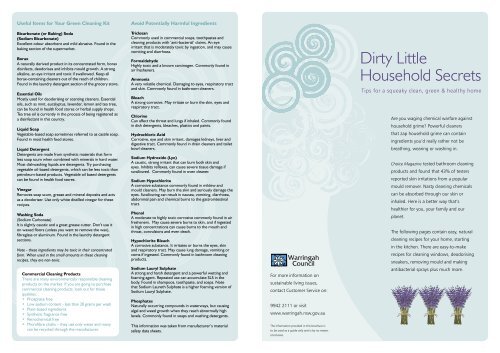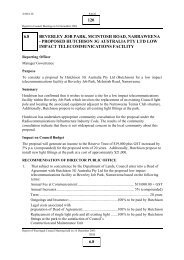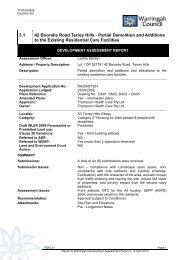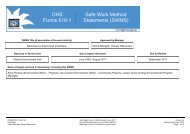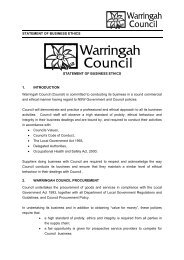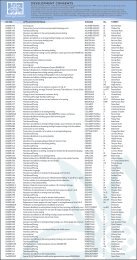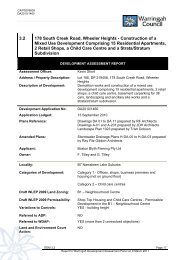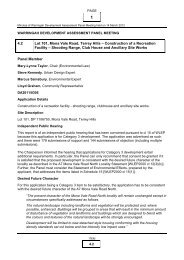Dirty Little Household Secrets
Dirty Little Household Secrets
Dirty Little Household Secrets
- No tags were found...
Create successful ePaper yourself
Turn your PDF publications into a flip-book with our unique Google optimized e-Paper software.
Useful Items for Your Green Cleaning KitAvoid Potentially Harmful IngredientsBicarbonate (or Baking) Soda(Sodium Bicarbonate)Excellent odour absorbent and mild abrasive. Found in thebaking section of the supermarket.BoraxA naturally derived product in its concentrated form, boraxdisinfects, deodorises and inhibits mould growth. A strongalkaline, an eye irritant and toxic if swallowed. Keep allborax-containing cleaners out of the reach of children.Found in the laundry detergent section of the grocery store.Essential OilsMostly used for deodorising or scenting cleaners. Essentialoils, such as mint, eucalyptus, lavender, lemon and tea tree,can be found in health food stores or herbal supply shops.Tea tree oil is currently in the process of being registered asa disinfectant in this country.Liquid SoapVegetable-based soap sometimes referred to as castile soap.Found in most health food stores.Liquid DetergentDetergents are made from synthetic materials that formless soap scum when combined with minerals in hard water.Most dishwashing liquids are detergents. Try purchasingvegetable oil-based detergents, which can be less toxic thanpetroleum-based products. Vegetable oil based detergentscan be found in health food stores.VinegarRemoves soap scum, grease and mineral deposits and actsas a deodoriser. Use only white distilled vinegar for theserecipes.Washing Soda(Sodium Carbonate)It is slightly caustic and a great grease cutter. Don’t use iton waxed floors (unless you want to remove the wax),fibreglass or aluminum. Found in the laundry detergentsections.Note - these ingredients may be toxic in their concentratedform. When used in the small amounts in these cleaningrecipes, they are non-toxic.Commercial Cleaning ProductsThere are many environmentally responsible cleaningproducts on the market. If you are going to purchasecommercial cleaning products, look out for thesequalities:• Phosphate free• Low sodium content - less than 20 grams per wash• Plant-based ingredients• Synthetic fragrance free• Petrochemical free• Microfibre cloths – they use only water and manycan be recycled through the manufacturer.TriclosanCommonly used in commercial soaps, toothpastes andcleaning products with ‘anti-bacterial’ claims. An eyeirritant that is moderately toxic by ingestion, and may causevomiting and diarrhoea.FormaldehydeHighly toxic and a known carcinogen. Commonly found inair fresheners.AmmoniaA very volatile chemical. Damaging to eyes, respiratory tractand skin. Commonly found in bathroom cleaners.BleachA strong corrosive. May irritate or burn the skin, eyes andrespiratory tract.ChlorineCan affect the throat and lungs if inhaled. Commonly foundin dish detergents, bleaches, plastics and paints.Hydrochloric AcidCorrosive, eye and skin irritant, damages kidneys, liver anddigestive tract. Commonly found in drain cleaners and toiletbowl cleaners.Sodium Hydroxide (Lye)A caustic, strong irritant that can burn both skin andeyes. Inhibits reflexes, can cause severe tissue damage ifswallowed. Commonly found in oven cleaner.Sodium HypochloriteA corrosive substance commonly found in mildew andmould cleaners. May burn the skin and seriously damage theeyes. Swallowing can result in nausea, vomiting, diarrhoea,abdominal pain and chemical burns to the gastrointestinaltract.PhenolA moderate to highly toxic corrosive commonly found in airfresheners. May cause severe burns to skin, and if ingestedin high concentrations can cause burns to the mouth andthroat, convulsions and even death.Hypochlorite BleachA corrosive substance. It irritates or burns the eyes, skinand respiratory tract. May cause lung damage, vomiting orcoma if ingested. Commonly found in bathroom cleaningproducts.Sodium Lauryl SulphateA strong and harsh detergent and a powerful wetting andfoaming agent. Repeated use can accumulate SLS in thebody. Found in shampoos, toothpaste, and soaps. Notethat Sodium Laureth Sulphate is a higher foaming version ofSodium Lauryl Sulphate.PhosphatesNaturally occurring compounds in waterways, but causingalgal and weed growth when they reach abnormally highlevels. Commonly found in soaps and washing detergents.This information was taken from manufacturer’s materialsafety data sheets.For more information onsustainable living issues,contact Customer Service on:9942 2111 or visitwww.warringah.nsw.gov.auThe information provided in this brochure isto be used as a guide only and is by no meansconclusive.<strong>Dirty</strong> <strong>Little</strong><strong>Household</strong> <strong>Secrets</strong>Tips for a squeaky clean, green & healthy homeAre you waging chemical warfare againsthousehold grime? Powerful cleanersthat zap household grime can containingredients you’d really rather not bebreathing, wearing or washing in.Choice Magazine tested bathroom cleaningproducts and found that 43% of testersreported skin irritations from a popularmould remover. Nasty cleaning chemicalscan be absorbed through our skin orinhaled. Here is a better way that’shealthier for you, your family and ourplanet.The following pages contain easy, naturalcleaning recipes for your home, startingin the kitchen. There are easy-to-makerecipes for cleaning windows, deodorisingsneakers, removing mould and makingantibacterial sprays plus much more.
KITCHENBATHROOMLight Surface Cleaner1 tsp lavender oil1 cup waterPour the water and lavender oil into a spray bottle. Shakethe mixture. Spray mixture onto surface and wipe off withsoft cloth.Antibacterial Spray1 cup water20 drops lemon essential oil10 drops lavender essential oil10 drops eucalyptus essential oilPour the water into a spray bottle. Blend the essential oilsin a glass jar with an eyedropper, and then add eight dropsof the oil mixture to the bottle of water. Spray on surfaceand leave for 15 minutes. No need to rinse. This recipe isgreat for surfaces where you really do need an antibacterialconcoction – such as chopping boards and toilet rims.Many essential oils contain antibacterial propertiesincluding lemon, clove, eucalyptus, tea tree, thyme andlavender oils.Drain Cleaner1 cup bicarbonate soda1 cup vinegar1 litre boiling waterSprinkle bicarbonate soda down offending drain. Pourvinegar in and watch the reaction. Follow with 1 litre ofboiling water. Wipe over drain plate with essential oil toleave a fresh fragrance. Baking soda (or bicarb) and salt canbe used instead (½ cup each).All Purpose CleanerBoraxBicarbonate sodaVinegarEucalyptus oilPlace borax and bicarbonate soda into a recycled glass jar.Mix in enough vinegar and water to make a paste. Add afew drops of eucalyptus oil. Wipe mixture onto surfaces tobe cleaned and wipe off with a soft cloth. A note on borax- this can be harmful to children and pets if swallowed, youcan make a milder version of this paste without the borax.Liquid Handwash250ml boiling water2 tsp glycerol or glycerine2 tbsp grated Sunlight soap2 tsp rosewaterAdd the grated soap to boiling water, stir and then let sitfor about 10 minutes until it melts. Stir in glycerol androsewater. When mixture is smooth, pour into dispenserbottle. Do this while it is still warm as it will set to a jellywhen cold and be difficult to pour.Air Freshener8 drops lavender oil4 drops each bergamot & clove oil2 drops peppermint oil½ cup vodka½ cup distilled waterCombine ingredients in spray bottle and shake well. Spritzinto air four or five times in area that needs freshening,being careful to avoid your eyes. A basic room spray canbe made by mixing four drops of any essential oil with300ml of warm (but not boiling) water.GENERALCarpet Cleaner2 tsp eucalyptus oil2 tsp glycerine2 tbsp vinegar2 tbsp bicarbonate soda2 tbsp methylated spiritsMix ingredients together into a spray bottle. For spotcleaning, spray the mixture onto the spot and gentlyrub with pantyhose. For a bigger spill – place pantyhoseover the head of a broom, spray lightly with your carpetcleaning mixture and sweep over the spot.Oven CleanerBicarbonate sodaVinegarSprinkle a little bicarbonate soda over oven surface. Sprayvinegar over bicarbonate soda (watch it sizzle!) then leaveovernight. Wipe off with a cloth dampened with water.Wipe over one final time with vinegar on your cloth.Dishwasher Detergent1 tbsp washing sodaUse 1 tbsp washing soda instead of commercial dishwasherdetergents. Caution – use this one at your own risk asdishwasher manufacturers are quite strict about what youshould use.Sink Cleaner1 cup vinegar1 cup waterFill a spray bottle with halfwater and half white vinegar.Spray on any surface wherethere is soap scum and leavefor 5 minutes. Wipe off.LAUNDRY*Laundry detergent½ cup grated pure soap1 cup hot waterGrate soap using a kitchen grater. Melt soap flakes in hotwater. You can add a few drops of your favourite essentialoil if you like. Pour into washing machine and wash asnormal. Alternatively, soapflakes are available for purchasein supermarkets.*“Caution – use this one at your own risk as manufacturers’ warrantiesare quite strict. Pour directly into the washing machine with your wash.Do not pour into soap dispensers.”<strong>Dirty</strong> Collar CleanerVinegarSimply spray vinegar onto the collar before putting itemthrough wash as usual. Hang item in the sun to dry. Thecombination of the sun and the vinegar should remove theoffending collar mark.Fabric Stain RemoversVinegarCold waterPure soap flakesIn general, protein stains (meat, blood etc) leave a darkoutline. Never use heat to remove them. Instead, treatwith cold water and pure soap. Carbohydrate stains arenormally dark in the centre. Treat with water, a spray ofvinegar and wash as normal in pure soap.Mould RemoverVinegarSaltMix equal parts vinegar and salt into a spray bottle. Sprayonto mouldy surface, leave for a few minutes and thenwipe off using a soft cloth.Bath & Shower Cleaner1 cup vinegar1 cup waterFill a spray bottle with half water and half white vinegar.Spray on any surface where there is soap scum and leavefor 5 minutes. Wipe off.Toilet Cleaner1 cup bicarbonate soda1 cup vinegarSprinkle bicarbonate soda into toilet bowl and pour vinegaron top. Watch it react. Leave it for ten minutes then cleanwith a toilet brush and flush.To finish, put a few drops of tea tree oil on a cloth andwipe around the bowl and seat to provide some antibacterialprotection (or use the antibacterial spray recipe).Smelly Sneaker Saver2 tbsp bicarbonate soda5 drops eucalyptus essential oilMix bicarbonate soda and essential oil (you can use anyone you like) into a container with small holes in the lid.Sprinkle mixture into your offending shoes and leaveovernight.Tiled or Timber Floor Cleaner1 cup vinegar1 bucket hot water5 drops eucalyptus essential oilAdd vinegar and essential oil (you can use any one you like)to a bucket of hot water. Lightly mop or wipe over surface.Window Cleaner1 part vinegar4 parts waterMix vinegar and water into a spray bottle. Spray ontowindows and wipe off with newspaper, window squeegeeor a soft cloth.Squeaky Clean Baby StepsDo your best to learn about whatever you cleanwith in your home. Scrutinise the labels on yourcleaning products and then go on a product diet.Phase out harmful commercial cleaning productsand replace them with healthy alternatives.


